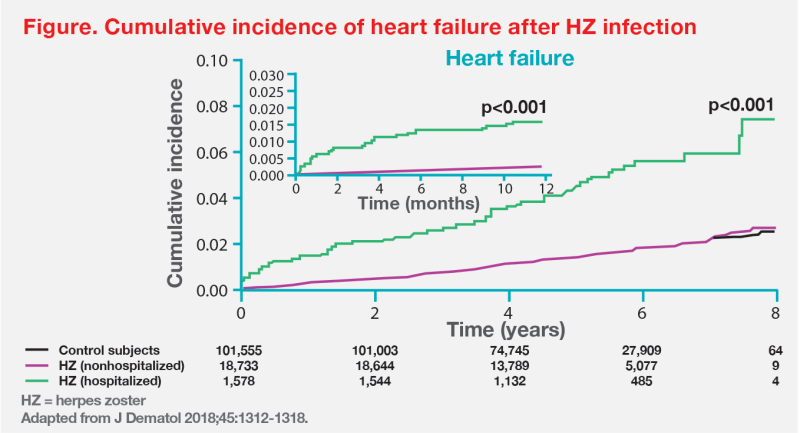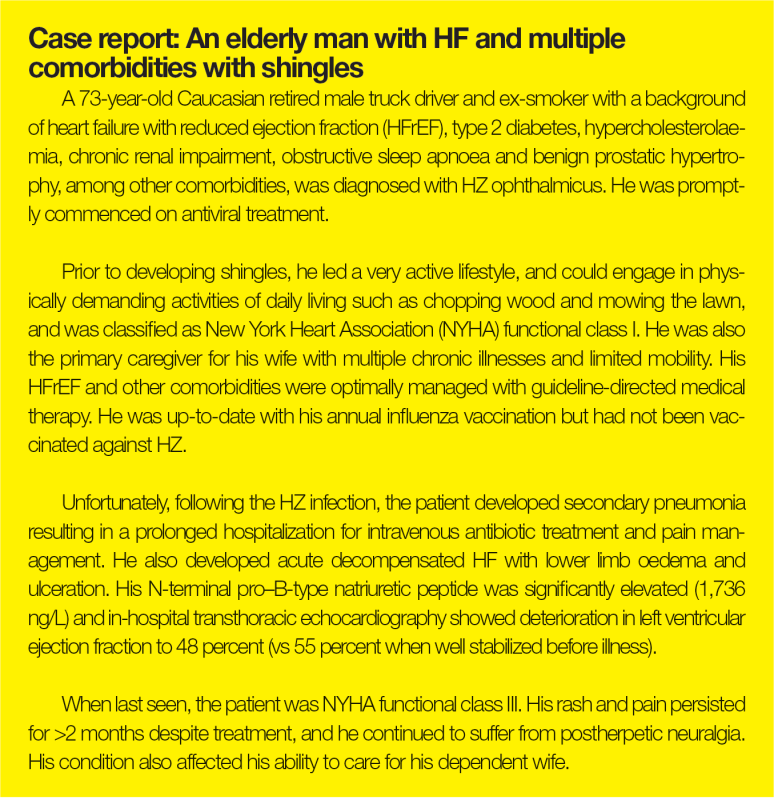Vaccination of vulnerable patients can reduce infection-associated CV risks





The elderly and patients with chronic conditions have increased susceptibility to viral infections such as herpes zoster (HZ) and respiratory syncytial virus (RSV), as well as higher risks of cardiovascular (CV) and other complications due to infection. At a recent symposium, Professor Timothy Tan of the Westmead and Blacktown Hospitals, and Western Sydney University, Sydney, Australia, shared insights on how the recombinant adjuvanted RSV vaccine (RSVPreF3) and recombinant zoster vaccine (RZV) can play an important role in preventing these infections, particularly in older individuals and those with comorbidities, thereby mitigating infection-associated risks.
More comorbidities spell higher HZ and RSV risk
“The risk of HZ infection is higher in patients with multiple comorbidities vs those with one comorbidity,” said Tan.
The risk of HZ is 1.4 times higher in patients with diabetes vs individuals in the general population, and higher still in diabetes patients with CV disease (CVD) vs those without. Similarly, a retrospective population based study reported that the incidence of RSV infection among hospitalized adults with coronary artery disease and congestive heart failure (HF) were 3.7–7.0 and 4.0–33.2 times higher, respectively, than in those without. [J Clin Endocrinol Metab 2022;107:586-597; Hum Vaccin Immunother 2017;13:2606-2611; BMC Infect Dis 2018;18:203; Clin Infect Dis 2022;74:1004-1011]
Consequences of infections in high-risk populations
“Immunosuppression due to chronic illness, age-related decline in immunity, a dysregulated immune system and inflammatory pathways are factors contributing to the increased risk of viral infection in individuals with chronic conditions such as HF and diabetes,” said Tan. [Transp Int 2009;22:1041-1050; BMC Cardiovasc Disord 2023;23:148; Rev Med Microbiol 2019;30:1-17; Clin Exp Nephrol 2019;23:437-447; Tex Heart Inst J 2004;31:4-13; Eur Heart J 2017;38:3195-3201]
“Acute viral infections may in turn exacerbate the inflammatory process and cellular immune dysfunction associated with vascular conditions, increasing CV morbidity and mortality,” he added. [Physiol Rev 2018;98:1417-1464; Am Coll Cardiol 2018;71:1574-1583; Rev Med Microbiol 2019;30:1-17; Nat Rev Cardiol 2020;17:543-558; Ann Am Thorac Soc 2015;12:S169-S175; Eur J Prev Cardiol 2024;31:877-888]
A Korean nationwide population-based retrospective case-control study (HZ patients, n=20,311; controls without HZ, n=101,555; 1:5 matched) from January 2006 to December 2013 found a reciprocal relationship between HZ and CVD. Severe HZ episodes requiring hospitalization increased the risk of acute myocardial infarct (MI) by nearly 1.7 times (hazard ratio [HR], 1.688; 95 percent confidence interval [CI], 1.247–2.283), ischaemic stroke by 1.4 times (HR, 1.425; 95 CI, 1.133–1.792), and exacerbation of underlying HF by almost two times (HR, 1.920; 95 percent CI, 1.524–2.419). (Figure) Likewise, patients with an episode of MI, ischaemic stroke or HF were also at increased risk of HZ hospitalization (after MI: HR, 1.625; 95 percent CI, 1.144–2.308; after stroke: HR, 1.518; 95 percent CI, 1.177–1.957; after HF: HR, 1.485; 95 percent CI, 1.041–2.117). [J Dematol 2018;45:1312-1318]

Hospitalizations related to diabetes management were also found to be 27 percent higher following an acute HZ episode. [Hum Vaccin Immunother 2017;13:2606-2611]
“Adults aged ≥50 years with RSV infection are at an increased risk of developing CV complications, such as acute MI or exacerbation of underlying HF during hospitalization,” said Tan. Cross-sectional analysis of the US RSV Hospitalization Surveillance Network data revealed that in adults ≥50 years old hospitalized with an RSV infection, the likelihood of developing CV complications was greater in those with pre-existing CVD (33 vs 22.4 percent in the overall population). Among patients with pre-existing CVD, the most common acute cardiac event was acute HF (25.3 percent), followed by an acute ischaemic cardiac event (10.2 percent). [JAMA Intern Med 2024;184:602-611]
Guideline recommendations
The elevated risks of infection associated CV and cerebrovascular events, their impact and burden, and the compelling evidence of safety and efficacy of vaccines (such as RZV and RSVPreF3) support vaccination as a prevention strategy against HZ and RSV infections in vulnerable populations, such as the elderly, immunocompromized, and those with chronic medical conditions. [Arch Peru Cardiol Cir Cardiovasc 2024;5:29-39; CHEST 2024, poster 3391; Open Forum Infect Dis 2022;9:ofac485; ECCMID 2024, abstract 09154; Clin Infect Dis 2023;76:e1335-e1340; Zoster-006 Clinical Study Report 110390; Zoster-022 Clinical Study Report 113077]
This is reflected in recommendations on HZ and RSV vaccination by various international guidelines and bodies, including the US Centers for Disease Control and Prevention Advisory Committee on Immunization Practices, the American Heart Association and the 2024 American College of Cardiology Expert Consensus, the Australian Immunisation Handbook and Hong Kong’s Centre for Health Protection. [MMWR Morb Mortal Wkly Rep 2024;73:696-702; J Am Coll Cardiol 2024;83:1444-1488; www.cdc.gov/vaccines/schedules/downloads/adult/adult-combined-schedule.pdf; www.heart.org/en/affiliates/thesevaccines-may-also-protect-your-heart; immunisationhandbook.health.gov.au/contents/vaccine-preventable-diseases; www.adultvax.thkma.org/%E8%A8%88%E5%8A%83%E5%85%A7%E5%AE%B9; www.info.gov.hk/gia/general/202309/27/P2023092700607.htm?fontSize=1]
Summary
“Current evidence and the patient case illustrate how a viral infection could exacerbate underlying chronic illness, which in turn can have an impact on quality of life and functional capacity. Hence, vaccination may be a relatively safe and effective way to reduce the impact of RSV and HZ,” Tan concluded.
